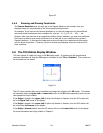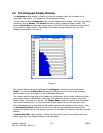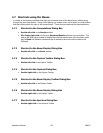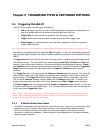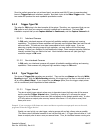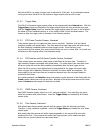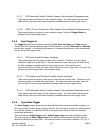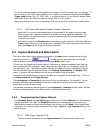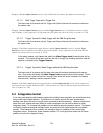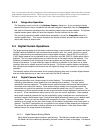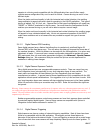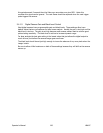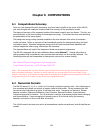
and ½ the maximum possible counts based on the number of A to D conversion bits. For example: If
you are using an LBA-712PC frame grabber (a 12 bit digitizer) you have the following possible Video
Trigger Level choices: 256, 512, 1024, 2048. If you set the level to 512, the LBA will capture a laser
beam pulse as soon as it detects a pixel raw energy value of 512 or greater.
Unless your camera is very noisy we recommend that you use the minimum level as a starting value.
5.1.5.1 CCD Frame and Interline Transfer Cameras, Interlaced
When the LBA is running, each digitized pixel is being tested for the trigger level pixel value.
When a trigger field is detected, the data is retained in the frame buffer and displayed. The
timing delay to the next frame that can be acquired depends upon the overhead needed to
process the first frame.
As in earlier examples, the Interline camera can display a pulse acquired in both fields while the
Frame transfer camera can only use one field. Because of the asynchronous arrival of the laser
pulse, the Frame transfer image will randomly hop fields.
5.2 Capture Methods and Rate Control
The rate at which data is being acquired can be seen in the Rate counter displayed at the far right
edge of the status line.
To determine the acquisition rate in frames per
second, divide the camera's frame rate by the indicated Rate counter value.
In every case, the fastest rate at which data can be acquired is ultimately dependent upon how you
have configured the LBA to operate. Rates slower than the fastest rate can, to a greater extent, be
controlled by the user. The fastest acquisition rates are thus determined by a combination of factors
that are dependent upon the selections made in the Capture, Computations, and Display dialog
boxes. In general, the more features you are using, the slower things will operate.
Two specific edit control items are provided that allow you to program the acquisition rate. These are
the Capture Interval, and Trigger Interval.
Frame Averaging and Summing will also figure into the rate calculations. For example, if you are
averaging 8 frames, then the acquisition time will increase by the amount of time that it takes to
acquire and average 8 frames of data.
The following examples are assuming that no frame Averaging or Summing is taking place, and that
all other overhead operations occur faster that the resulting acquisition rates.
5.2.1 Programming the Capture Interval
In Continuous, Block, and Live Video Capture Methods, the Capture Interval value will determine
the data acquisition rate. With the Single Shot Method, this value becomes a delay count that
determines the number of frames that will elapse from the time you click Start!, until a single frame
is acquired. The capture interval interacts with the Trigger Type and Trigger Interval settings in the
following ways:
5.2.1.1 With Trigger Type set to CW
The frame rate of the camera and the Capture Interval will determine the capture rate.
Operator’s Manual LBA-PC
122



